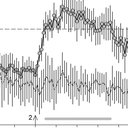Arterial [H+] and the ventilatory response to hypoxia in humans: influence of acetazolamide-induced metabolic acidosis.
Märksõnad
Abstraktne
In this study, we investigated possible separate effects of H+ ions and CO2 on hypoxic sensitivity in humans. We also examined whether hypoxic sensitivity, conventionally defined as the ratio of (hypoxic - normoxic) ventilation over (hypoxic - normoxic) Hb oxygen saturation can also be estimated by taking the ratio (hypoxic - normoxic) ventilation over (logPa(O2) hypoxia - logPa(O2) normoxia), enabling one to measure the hypoxic response independently from potential confounding influences of changes in position of the Hb oxygen saturation curve. We used acetazolamide to induce a metabolic acidosis. To determine the acute hypoxic response (AHR), we performed step decreases in end-tidal Po2 to approximately 50 Torr lasting 5 min each at three different constant end-tidal Pco2 levels. Nine subjects ingested 250 mg of acetazolamide or placebo every 8 h for 3 days in a randomized double-blind crossover design. The metabolic acidosis was accompanied by a rise in ventilation, a substantial fall in Pa(CO2), and a parallel leftward shift of the ventilatory CO2 response curve. In placebo, CO2 induced equal relative increases in hypoxic sensitivity (O2-CO2 interaction) regardless of the way it was defined. Acetazolamide shifted the response line representing the relationship between hypoxic sensitivity and arterial [H+] ([H+](a)) to higher values of [H+](a) without altering its slope, indicating that it did not affect the O2-CO2 interaction. So, in contrast to an earlier belief, CO2 and H+ have separate effects on hypoxic sensitivity. This was also supported by the finding that infusion of bicarbonate caused a leftward shift of the hypoxic sensitivity-[H+](a) response lines in placebo and acetazolamide. A specific inhibitory effect of acetazolamide on hypoxic sensitivity was not demonstrated.


